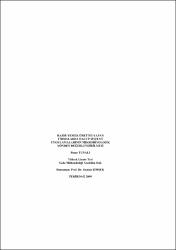| dc.contributor.author | Tunalı, Pınar | |
| dc.date.accessioned | 2017-04-25T06:53:05Z | |
| dc.date.available | 2017-04-25T06:53:05Z | |
| dc.date.issued | 2009 | |
| dc.identifier.uri | https://hdl.handle.net/20.500.11776/437 | |
| dc.description.abstract | Bu araştırma, İstanbul ilindeki HACCP sistemine sahip 16 farklı hazır yemek üretimi yapan işletmelerden alınan örneklerin mikrobiyolojik analizleri yapılarak HACCP sisteminin etkinliğini belirlenmiştir. Araştırmada 16 personel el numunesi, 16 ekipman-yüzey numunesi, 13 meyve-sebze depo ortam numunesi, 12 pişmiş yemek numunesi, 4 salata numunesi ve 16 üretim suyu numunesi olmak üzere toplam 77 adet numune alınmış ve mikrobiyolojik analizleri yapılmıştır. Personel el numunelerinde Koliform, Escherichia coli ve Staphylococcus aureus varlığına bakılmıştır. Bunlardan 7 (%43,75) adedi temiz bulunurken 9 (%56,25) adedi kirli, ekipman-yüzey örneklerinden 8 (%50) adedi temiz, 8 (%50) adedinin kirli, meyve-sebze depo ortam numunelerinin Toplam Canlı ve Küf bakımından varlığı 5 (%37,5) adedi kirli, 8 (%61,5) adedi temiz olduğu tespit edilmiştir. Alınan yemek numunelerinin mikrobiyolojik sonuçlarının %75’i temiz bulunurken %25’inin yenemeyecek düzeyde olduğu, üretim de kullanılan şebeke suyunun tamamının temiz olduğu belirlenmiştir. | en_US |
| dc.description.abstract | This study has identify the efficiency of the HACCP system in 16 catering operators in the province of Istanbul by means of sample-taking for microbiological analysis. In this study, 16 manual samples were taken from the staff, 16 from the equipment surface, 13 from the environment in the fruits and vegetables storage, 12 from the cooked food, 4 from the salad, 16 from the production water, amounting to a total of 77 samples the microbiological anaylses of which were conducted. The samples taken from the hands of the staff were investigated for the presence of coliform, Escherichia coli and Staphylococcus aureus. 7 (43,75%) of these were found clean, 9 (56,25%) were contaminated. 8 of the equipment surface samples (50%) were clean, 8 (50%) were contaminated. The Total Organism and Moulds Presence was investigated in the samples taken from the fruits and vegetables storage. 5 of these were contaminated (37,5%), 8 were clean (61,5%). The microbiological results of the food samples showed that 75% were clean and 25% were inedible. All of the tap water used in the production was clean. | en_US |
| dc.language.iso | tur | en_US |
| dc.publisher | Namık Kemal Üniversitesi | en_US |
| dc.rights | info:eu-repo/semantics/openAccess | en_US |
| dc.subject | HACCP | en_US |
| dc.subject | mikrobiyoloji | en_US |
| dc.subject | hazır yemek | en_US |
| dc.subject | microbiology | en_US |
| dc.subject | catering | en_US |
| dc.title | Hazır yemek üretimi yapan firmalarda HACCP sistemi uygulamalarının mikrobiyolojik yönden değerlendirilmesi | en_US |
| dc.title.alternative | Microbiological evaluation of HACCP system practices in catering operators | en_US |
| dc.type | masterThesis | en_US |
| dc.department | Enstitüler, Fen Bilimleri Enstitüsü, Gıda Mühendisliği Ana Bilim Dalı | en_US |
| dc.relation.publicationcategory | Tez | en_US |



















